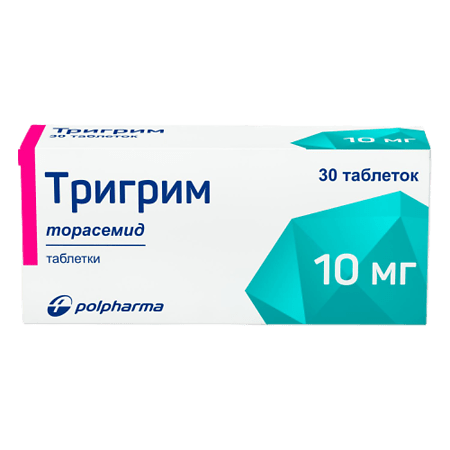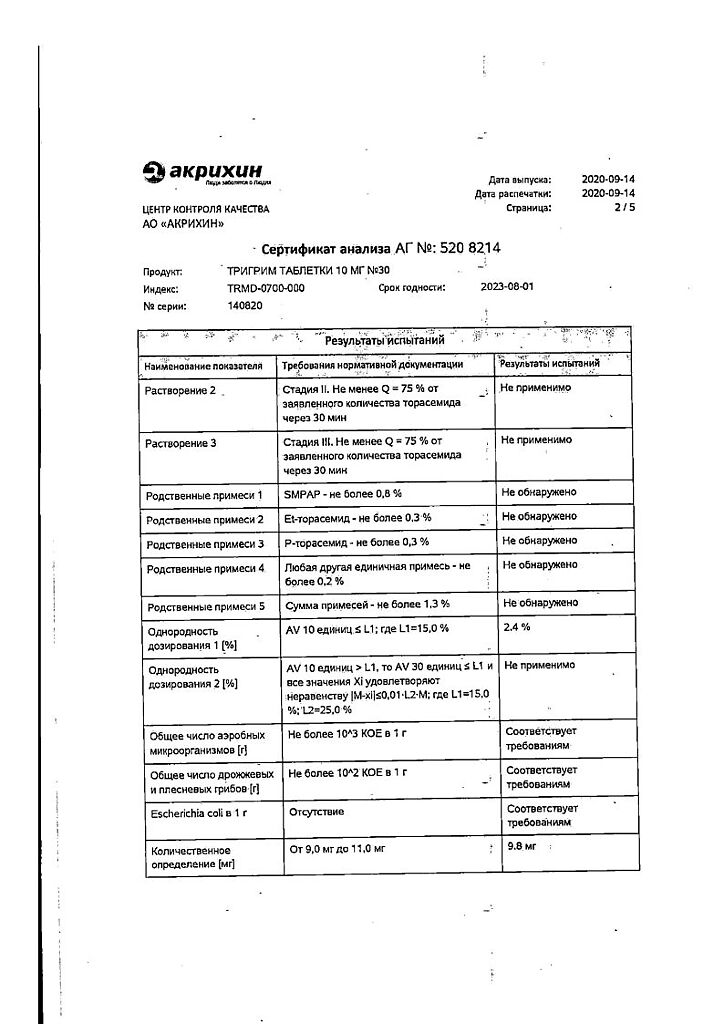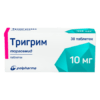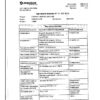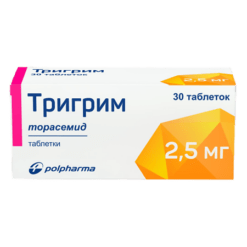No products in the cart.
Trigrim, tablets 10 mg 30 pcs
€17.93 €14.94
Description
Diuretic drug.
The main mechanism of action is due to the reversible binding of thoracemide to the Na+/2Cl–/K+ transporter.located in the apical membrane of the thick segment of the ascending loop of Genle, it reduces or completely inhibits the reabsorption of sodium ions, which leads to a decrease in the osmotic pressure of intracellular fluid and water reabsorption. At the same time, due to anti-aldosterone action, thorasemide causes hypokalemia to a lesser extent than furosemide, with greater activity and duration of action.
Pharmacokinetics
absorption
After oral administration, thoracemide is rapidly and almost completely absorbed from the gastrointestinal tract. Cmax of torasemide in plasma is noted 1-2 h after ingestion. Bioavailability is about 80-91% or more in edema.
Eating has no effect on absorption of the drug.
Distribution
The binding to plasma proteins is 99%. Vd – 16 liters.
Metabolism
Metabolized in the liver with the participation of cytochrome P450 system isoenzymes to form 3 metabolites M1, M3 and M5.
Evolution
T1/2 of torasemide and its metabolites in healthy volunteers is 3-4 h. Total clearance of torasemide is 40 ml/min and renal clearance is about 10 ml/min. On average 80-83% of taken dose is excreted by kidneys through tubular secretion unchanged (24-25%) and as metabolites (M1 – 11-12%, M3 – 3%, M5 – 41-44%).
Pharmacokinetics in special clinical cases
In renal failure T1/2 torasemide does not change.
Indications
Indications
Active ingredient
Active ingredient
Composition
Composition
Associates:
Lactose,
Corn starch,
Colloidal silicon dioxide,
Magnesium stearate.
How to take, the dosage
How to take, the dosage
The drug is administered in adults, orally, regardless of meals.
In case of edema
The drug is prescribed in a dose of 5 mg once daily. If necessary, the dose may be gradually increased to 20 mg once daily. In individual cases it is recommended to use up to 40 mg/day.
In edema associated with congestive heart failure
Prescribes a dose of 5-20 mg 1 time/day. If necessary, the daily dose may be gradually increased, doubling it to a maximum of 200 mg.
In cases of edema due to chronic renal failure
The starting dose is 20 mg/day. If necessary, this dose may be gradually increased, doubling it, until optimal diuretic action is achieved. The maximum daily dose is 200 mg.
In cases of edema associated with cirrhosis
The drug is indicated in a dose of 5-10 mg once daily. If necessary, this dose may be gradually increased, doubling it, until appropriate diuretic action is achieved. There have been no appropriately controlled studies in patients with liver disease using doses greater than 40 mg/day.
In primary arterial hypertension
The dose is 2.5 mg once daily. If necessary, the dose may be gradually increased to 5 mg/day. According to studies, a dose greater than 5 mg/day does not lead to a further decrease in BP. Maximum effect is achieved after about 12 weeks of continuous treatment.
Patients of advanced age do not require dose adjustment.
Interaction
Interaction
Trigrim® increases myocardial sensitivity to cardiac glycosides in potassium or magnesium deficiency. When concomitantly taken with mineralocorticoids, glucocorticoids, and laxatives, potassium excretion may be increased.
Trigrim® increases the effect of hypotensive drugs.
In high dosesTrigrim® can increase the toxic effects of aminoglycosides, antibiotics, cisplatin; nephrotoxic effects of cephalosporins, and the cardio- and neurotoxic effects of lithium.
Torasemide may increase the effects of curare-like myorelaxants and theophylline.
When using salicylates in high doses, their toxic effects may be enhanced and, conversely, the effects of antidiabetic agents may be weakened.
The sequential or simultaneous use of thoracemide with ACE inhibitors may lead to a transient drop in BP. This can be avoided by reducing the starting dose of ACE, or by reducing the dose of thorasemide (or temporarily stopping it).
Torasemide reduces the effect of vasoconstrictors (epinephrine and norepinephrine).
NSAIDs and probenecid may decrease the diuretic and hypotensive effects of torasemide.
Colestyramine may decrease absorption of thoracemide from the gastrointestinal tract (in experimental animal studies).
Special Instructions
Special Instructions
In long-term treatment it is recommended to monitor electrolyte balance, glucose, uric acid, creatinine and blood lipids.
In case of hypokalemia, hyponatremia, hypovolemia or urinary disorders, all these conditions should be corrected before prescribing Trigrim.
In the presence of diabetes mellitus it is necessary to control carbohydrate metabolism.
In case of thrombocytopenia or inhibition of bone marrow function or skin rashes, the drug should be discontinued.
Pediatric use
There are no data regarding the use of Trigrim in children.
Influence on driving and operating machinery
In the initial phase of administration, it is not recommended to drive vehicles and operate machinery because of the possibility of dizziness.
Contraindications
Contraindications
With caution the drug should be used in patients with:
Side effects
Side effects
Hematopoietic system disorders: in some cases – decrease in the number of erythrocytes and leukocytes and platelets.
Metabolism disorders: in some cases – hypovolemia, electrolyte imbalance, hypokalemia, increased serum levels of uric acid, glucose and lipids.
Cardiovascular system disorders:in some cases – circulatory disorders and thromboembolism (due to dehydration), BP decrease.
In the digestive system: Symptoms of gastrointestinal dysfunction, loss of appetite, dry mouth; in some cases – increased activity of liver enzymes (including GGT), pancreatitis.
Since the urinary system: acute urinary retention, increased plasma levels of urea and creatinine.
CNS and peripheral nervous system disorders: headache, dizziness, weakness, drowsiness, confusion, convulsions, paresthesias in the extremities.
Sensory organs: disorders of vision, tinnitus, deafness.
Allergic reactions:cutaneous itching, rashes and photosensitization.
Overdose
Overdose
Pregnancy use
Pregnancy use
The drug Trigrim is contraindicated during pregnancy, lactation, under 18 years of age (efficacy and safety not established).
Similarities
Similarities
Additional information
| Shelf life | 3 years. |
|---|---|
| Conditions of storage | In a dry, light-protected place at a temperature not exceeding 25 °C. |
| Manufacturer | Akrihin HFC JSC, Russia |
| Medication form | pills |
| Brand | Akrihin HFC JSC |
Other forms…
Related products
Buy Trigrim, tablets 10 mg 30 pcs with delivery to USA, UK, Europe and over 120 other countries.

